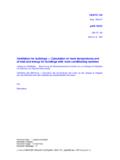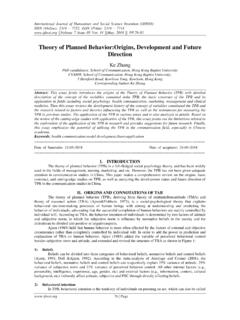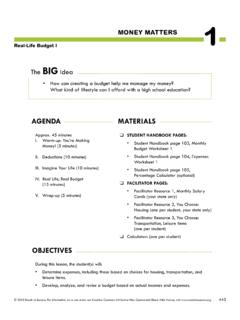Transcription of Theory of Planned Behaviour - cres.gr
1 Theory of Planned Behaviour The Theory of Planned Behaviour is one of the models most frequently used in the literature to explore pro-environmental Behaviour including recycling, travel mode choice, energy consumption, water conservation, food choice, and ethical investment (Stern, 2000; Staats, 2003). Armitage and Conner (2001) identified its application in 154 different contexts. The Theory of Planned Behaviour (Ajzen, 1988) assumes that the best prediction of Behaviour is given by asking people if they are intending to behave in a certain way. Here we note that the intention will not express itself in Behaviour if it is physically impossible to perform the Behaviour or if unexpected barriers stand in the way. Assuming intention can explain Behaviour , how can intention be explained?. According to Azjen, three determinants explain behavioural intention: 1.
2 The attitude (opinions of oneself about the Behaviour ); 2. The subjective norm (opinions of others about the Behaviour ); 3. The perceived behavioural control (self-efficacy towards the Behaviour ). Figure 1. The Theory of Planned Behaviour attitude According to the model attitudes, subjective norms and perceived behavioural control predict the intention, which in turn predicts the Behaviour . Background variables, as demographical factors, are supposed to influence the Behaviour through the three determinants and the intention. Attitudes, subjective norms and the perceived behavioural control, explain the behavioural intention before the Behaviour takes place. The intention is a good predictor of the actual Behaviour . Theory also says that the perceived behavioural control is an estimate of the skills needed for expressing the Behaviour and the possibility to overcome barriers.
3 Therefore, a direct influence of perceived behavioural control on Behaviour is supposed. The actual Behaviour leads to feedback about the expectations of the Behaviour . In Figure 1, this is shown by the feedback arrow. Furthermore, Ajzen states that for a good and predictive value of the model, it is necessary that the several model variables are defined on the same level of specificity: For example, when investigating the explaining factors of buying solar subjective norm Perceived behavioural control Intention feedbackbehaviour background variables boilers, prediction will not be found in the attitude toward the environment, but in the attitude toward solar boilers. If one wants to study pro-environmental Behaviour in general, than the determinants should be measured on this general level. Comments on Theory of Planned Behaviour The model of the Theory of Planned Behaviour assumes that consumers make decisions by calculating the costs and benefits of different courses of action and choosing the option that maximises their expected net benefits.
4 The Theory of Planned Behaviour belongs to the so-called group of rational choice models . It builds on the following key assumptions: - Individual self-interest is the appropriate framework for understanding human Behaviour ; rational Behaviour is the result of processes of cognitive deliberation; - Internal factors, especially the attitude, play the most important role. The policy interventions that flow from this model are relatively straightforward. Policy should seek to ensure that consumers have access to sufficient information to make informed choices. Though familiar and widely used, rational choice models have been subject to an extended critique. This critique is based on the following important claims and arguments. It is well known that human Behaviour is extremely complex and consists of social, moral and altruistic Behaviour as well as simply self- interested ones.
5 More often, Behaviour is embedded in collective and social decision-making contexts and other contextual factors. These factors continually shape and constrain individual preference. Habits and routines - which Simon (1957) referred to as procedural rationality - bypass cognitive deliberation and undermine a key assumption of the model. Emotional or affective responses appear to confound cognitive deliberation. It is well known in marketing Theory , for example, that consumers build affective relationships with consumer goods.








